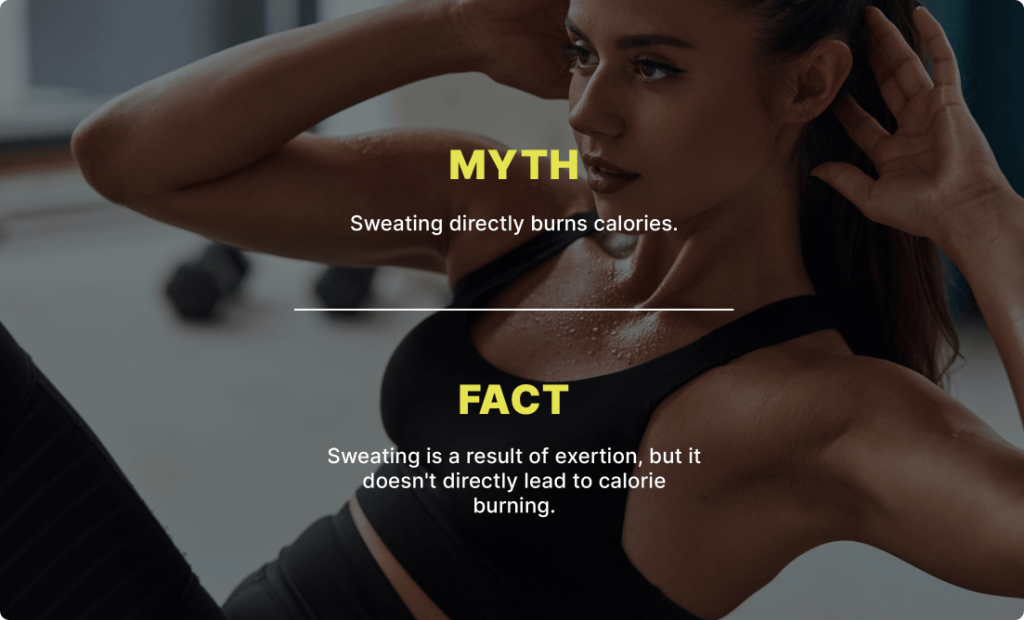Have you ever found yourself drenched in sweat after a grueling workout session? It’s hard not to associate those rivulets of perspiration with a sense of accomplishment and the notion that you must be burning loads of calories. Sweating has long been considered a symbol of exertion and a measure of a good workout. But does sweating actually burn calories? Are those sweat-soaked gym clothes an indication of a more effective calorie-burning session?
In this blog, we delve into the facts about sweat and weight loss, separating myth from reality to help you better understand the relationship between sweating and calorie burn. Get ready to explore the science behind those glistening beads and continue reading to discover the truth about sweating and its impact on your weight loss journey.
What Causes Sweating?
Before we dive into the correlation between sweat and weight loss, it’s crucial to understand the underlying factors that cause us to sweat. Sweating is not just a random bodily response but a finely tuned mechanism designed to help us maintain our body temperature and adapt to various conditions. So, let’s unravel the fascinating facts behind what actually causes us to break a sweat.
1. The Thermoregulatory Function
Our bodies are remarkable at regulating temperature, and sweating plays a vital role in this process. When our internal temperature rises due to factors like physical exertion or exposure to heat, the hypothalamus, a region in the brain, springs into action. It triggers the sweat glands to produce sweat as a cooling mechanism, enabling our body to maintain a stable core temperature.
2. Sweat Glands at Work
Sweat glands, scattered throughout our skin, are responsible for sweat production. The two primary types of sweat glands are eccrine and apocrine glands. Eccrine glands are abundant and secrete a watery sweat composed of water, salt, and trace minerals. Apocrine glands, found primarily in areas with hair follicles, produce a thicker and more odorous sweat.
3. Evaporation and Cooling
The main purpose of sweating is to facilitate evaporative cooling. As sweat is released onto our skin, it evaporates due to the surrounding air’s heat, drawing heat energy away from our bodies. This process effectively cools down our skin and helps regulate our overall body temperature.

4. Exercise-Induced Sweating
Physical activity causes an increase in body heat production. As our muscles work harder, more heat is generated, leading to a rise in body temperature. In response, the sweat glands kick into high gear, producing more sweat to cool us down. This is why we often find ourselves drenched in sweat after a vigorous workout session.
5. Emotional and Stress-Related Sweating
Sweating is not solely triggered by physical exertion or heat. Emotions and stress can also stimulate sweat production. When we’re feeling anxious, nervous, or stressed, our sympathetic nervous system activates, leading to the release of stress hormones. These hormones can stimulate the sweat glands, causing emotional sweating.
Does Sweating Really Burn Calories?
No, sweating alone does not directly burn a significant number of calories. During a workout, however, body heat is generated, which is a sign that you are expending energy. As we sweat to lower the body temperature, it indirectly indicates that we are burning calories. Since sweating can be triggered by factors other than physical activity, linking sweating directly with the loss of calories would be a mistake. The accurate measure of calorie burn lies in the intensity of your workout, not the amount of sweat produced. Surprisingly, activities like yoga, swimming, or even light weight lifting can burn calories without necessarily causing excessive sweating. Additionally, working out in cold environments may not result in much sweat, but it can still contribute to calorie expenditure.
Just remember that you do not necessarily have to sweat to burn a lot of calories during an intense workout, but it is a good chance that you will break a sweat if you are doing a challenging workout mixing cardio and strength training.

Does Sweating Help in Weight Loss?
When we engage in intense physical activity, we may sweat profusely, leading us to believe we’re shedding pounds. However, this weight loss is primarily due to the loss of water through sweating, and it can be easily regained by rehydrating. While sweating can result in a temporary loss of a few pounds, it’s crucial to recognize that this is predominantly water weight. Once your body cools down and you rehydrate, the lost weight will be regained. Therefore, relying solely on sweat as an indicator of weight loss is misleading. Sweat is primarily a mechanism for cooling the body and regulating temperature, not a direct contributor to weight loss.
Are There Any Benefits and Risks of Sweating?
Sweating offers a number of benefits to our bodies. Primarily, it regulates our body temperature and protects us from overheating. Sweating may also help detoxify, i.e., getting rid of toxic chemicals from our bodies. There are differing opinions on the efficacy of sweating as a detox mechanism. Still, several studies do show that our bodies sweat out toxins, heavy metals, and bacteria in small quantities.
One must remember that sweating too much can be risky, as it may lead to dehydration, a serious condition that needs immediate medical attention. To prevent dehydration, remember to drink enough water daily and keep yourself hydrated before and after any intense physical activity that results in lots of sweating.

The Bottom Line
In conclusion, while sweating is a natural process that helps regulate body temperature during physical activity, it is important to dispel the misconception that sweating directly leads to calorie burning or fat loss. People sweat for various reasons, and the amount of sweat produced does not directly correlate with the number of calories burned or the effectiveness of a workout.
Factors such as genetics, fitness level, environmental conditions, and individual differences contribute to the amount of sweat generated, making it an unreliable indicator of calorie burn. Instead, the true measure of calories and burning fat lies in the nature and intensity of the workout itself. To achieve effective calorie burning and fat loss, focus on engaging in challenging exercises that elevate your heart rate and promote overall energy expenditure. Combine this with a well-balanced diet to create a calorie deficit necessary for weight loss.
Start Your Fitness Journey Today with Vision Sports Club
If you still have some questions or if you are looking for professional help to kickstart your fitness journey, we have the answers at Vision Sports Club. We have the right personnel, equipment, and expertise to get you started, and our certified personal training instructors are available to provide you with expert advice and guidance. Additionally, with our private coaching option, you can receive a customized training plan tailored to your specific goals and needs. So, Start your fitness journey today with the help of our experienced and certified team of personal trainers.


